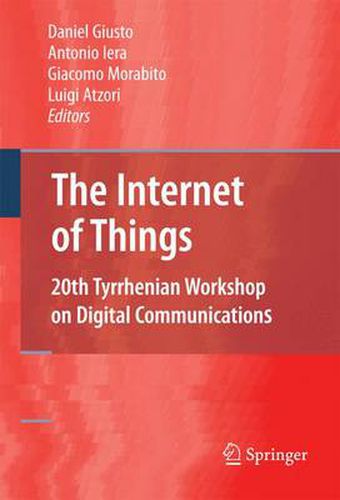Readings Newsletter
Become a Readings Member to make your shopping experience even easier.
Sign in or sign up for free!
You’re not far away from qualifying for FREE standard shipping within Australia
You’ve qualified for FREE standard shipping within Australia
The cart is loading…






This title is printed to order. This book may have been self-published. If so, we cannot guarantee the quality of the content. In the main most books will have gone through the editing process however some may not. We therefore suggest that you be aware of this before ordering this book. If in doubt check either the author or publisher’s details as we are unable to accept any returns unless they are faulty. Please contact us if you have any questions.
In the last few years, a stimulating idea is fast emergingin the wireless scenario: the pervasive presence around us of a variety of things or objects , such as RFID, sensors, actuators, mobile phones, which, through unique addressing schemes, are able to interact with each other and cooperate with their neighboring smart c- ponents to reach common goals. This novel paradigm, named The Internet of Things (IoT) continues on the path set by the concept of smart environments and paves the way to the depl- ment of numerous applications with a signi cant impact on many elds of future every-day life. In this context, logistics, Intelligent Transportation Systems (ITS), business/process management,assisted living, and e-health are only a few examples of possible application elds in which this novel paradigm will play a leading role in the next future. Actually,manychallengingissues still needto be addressedand both technolo- calandsocialnodesuntiedbeforethe IoTideabeingwidelyaccepted.Centralissues are making a full interoperabilityof such devices possible, enablingtheir adaptation and autonomousbehavior, as well as guaranteeingtrust, privacy,and security. Also, the IoT idea poses several new problemsconcerningthe networkingaspects. In fact, the things composing the IoT will be characterized by low resources in terms of both computation and energy capacity. Accordingly, the proposed solutions need to payspecial attentionto resourceef ciencybesides the obviousscalability problems. The papers included in this volume present a picture of the current state of the art on the above issues; more speci cally, concepts and ideas are discussed on n- working, middleware, security and privacy, RFID and sensor networks, as well as electromagnetic aspects.
$9.00 standard shipping within Australia
FREE standard shipping within Australia for orders over $100.00
Express & International shipping calculated at checkout
This title is printed to order. This book may have been self-published. If so, we cannot guarantee the quality of the content. In the main most books will have gone through the editing process however some may not. We therefore suggest that you be aware of this before ordering this book. If in doubt check either the author or publisher’s details as we are unable to accept any returns unless they are faulty. Please contact us if you have any questions.
In the last few years, a stimulating idea is fast emergingin the wireless scenario: the pervasive presence around us of a variety of things or objects , such as RFID, sensors, actuators, mobile phones, which, through unique addressing schemes, are able to interact with each other and cooperate with their neighboring smart c- ponents to reach common goals. This novel paradigm, named The Internet of Things (IoT) continues on the path set by the concept of smart environments and paves the way to the depl- ment of numerous applications with a signi cant impact on many elds of future every-day life. In this context, logistics, Intelligent Transportation Systems (ITS), business/process management,assisted living, and e-health are only a few examples of possible application elds in which this novel paradigm will play a leading role in the next future. Actually,manychallengingissues still needto be addressedand both technolo- calandsocialnodesuntiedbeforethe IoTideabeingwidelyaccepted.Centralissues are making a full interoperabilityof such devices possible, enablingtheir adaptation and autonomousbehavior, as well as guaranteeingtrust, privacy,and security. Also, the IoT idea poses several new problemsconcerningthe networkingaspects. In fact, the things composing the IoT will be characterized by low resources in terms of both computation and energy capacity. Accordingly, the proposed solutions need to payspecial attentionto resourceef ciencybesides the obviousscalability problems. The papers included in this volume present a picture of the current state of the art on the above issues; more speci cally, concepts and ideas are discussed on n- working, middleware, security and privacy, RFID and sensor networks, as well as electromagnetic aspects.